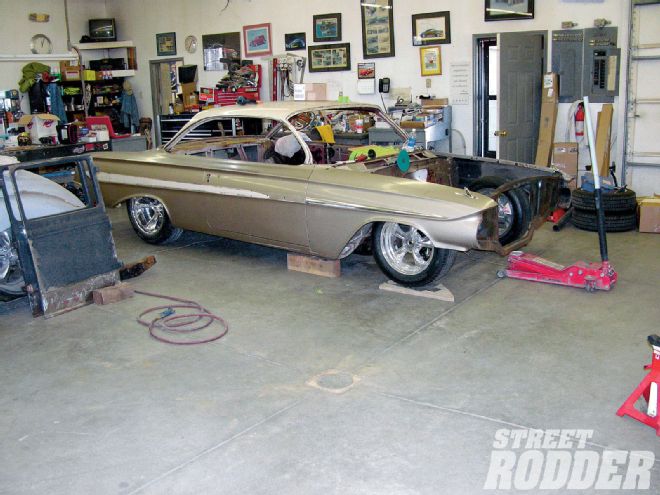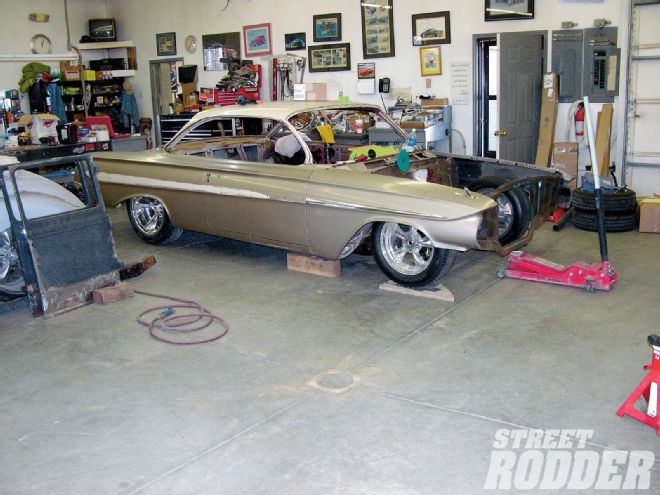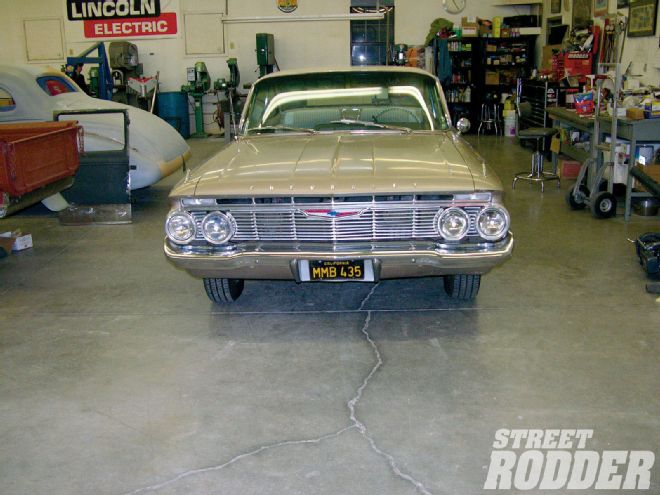
One of the most important factors when building a street rod, regardless of its year, is the stance-attitude is all about altitude.
 One of the latest projects to get the full-on Alloway's Hot Rod Shop treatment is this '61 Chevrolet. From 1958-64, Chevrolet and other GM cars used an X, or cruciform frame introduced by Cadillac in 1957. They would all be a candidate for what is shown here.
One of the latest projects to get the full-on Alloway's Hot Rod Shop treatment is this '61 Chevrolet. From 1958-64, Chevrolet and other GM cars used an X, or cruciform frame introduced by Cadillac in 1957. They would all be a candidate for what is shown here.
Although the first consideration when lowering a car is usually its appearance, the related issues of suspension travel and handling must also be considered. There are probably a few among us who can remember using a torch to heat the springs on a car to drop it only to find that crusing around on the bumpstops make for a miserable ride. Today most of us also realize that pounding bottomed out suspension components is an invitation for something to fail and that is a scenario that seldom ends well. Of course the lack of suspension travel will also destroy a car's handling. Adequate, controlled suspension travel is what allows the tires to stay in contact with the road and handle surface irregularities at the same time.
Someone who has a complete understanding of how to get a car low and make it driveable is Bobby Alloway-and while all the cars that roll out of Alloway's Hot Rod Shop are unique, they all share one common attribute-they sit bitchin'. Alloway's approach to building a street rod is simple and effective: yank the stock suspension, put the wheels and tires to be used under the fenders with the car mocked up at ride height (which means a 3-degree nose down rake and 4-5 inches of ground clearance at the cowl), then build the suspension and everything else to fit. The result is a car that's low, looks cool, and has enough ground clearance that it can be driven just about anywhere.
Recently team Alloway began work on a '61 Chevrolet Impala. Like many '50s and '60s cars, to get this one low and improve its road manners an entirely new front suspension would be required. While a new frame could have been constructed, a less invasive and more affordable alternative is available in the form of a front clip from Art Morrison Enterprises. Morrison offers a variety of CAD engineered replacement frames, front clips, as well as what they call a bikini clip. Available for virtually any application, the bikini clip can be custom-built to accommodate different frame rail widths, tread dimensions, and ride heights. The proper width rack-and-pinion steering is used for each application to prevent bumpsteer and coil springs, air springs, or ShockWaves are available. In addition, clips are available with two suspension system configurations, the Deluxe IFS and the Sport IFS.
 Chevrolet built over a million cars during the '61 model run and was number one in sales. This cherry Impala was purchased from the original owner's family. An interesting aside is that the SS package was available as a dealer-installed option.
Chevrolet built over a million cars during the '61 model run and was number one in sales. This cherry Impala was purchased from the original owner's family. An interesting aside is that the SS package was available as a dealer-installed option.
Before we look at the differences between the two suspension systems, here are some terms you should know:
Antidive: minimizes nose-dive during hard braking.
Caster: provides for stable highway manners and positive steering feel.
Camber gain: Camber gain is minimized during braking, providing more of the tire's footprint in contact with the pavement for shorter stopping distances.
Roll center movement: moves with chassis during bump and rebound at a 1:1 ratio for stable handling in all situations.
Static roll center: at rest, the roll center sits low for reducing jacking effects and reduces the possibility of heavy oversteer.
Comparing the Deluxe and Sport Suspensions The Sport Suspension offers: Larger polyurethane bushings: reduce noise and vibration while maintaining proper geometry.
Larger diameter tubing: provides higher stiffness yet keeping weight at a minimum. This reduces unsprung weight for a better ride. Unique upper control arm design allows the use of large front tires.
Reduced roll center movement: RC lateral movement of less than 3 inches provides confident transitional handling on par with many of today's high-performance cars.
Camber gain: is aggressive enough for occasional track duty, yet provides long tire life as well.
Increased caster: is set up to 6 degrees for stable highway manners and positive steering feel.
Increased antidive: antidive is set to minimize nose dive during hard braking without resorting to higher spring rates, giving a more comfortable ride and safer braking.
Regardless of which suspension option is used, an Art Morrison bikini clip is a win-win situation. It's an affordable, safe method to get a car that will hug the ground as well as the corners-and do it with plenty of attitude.